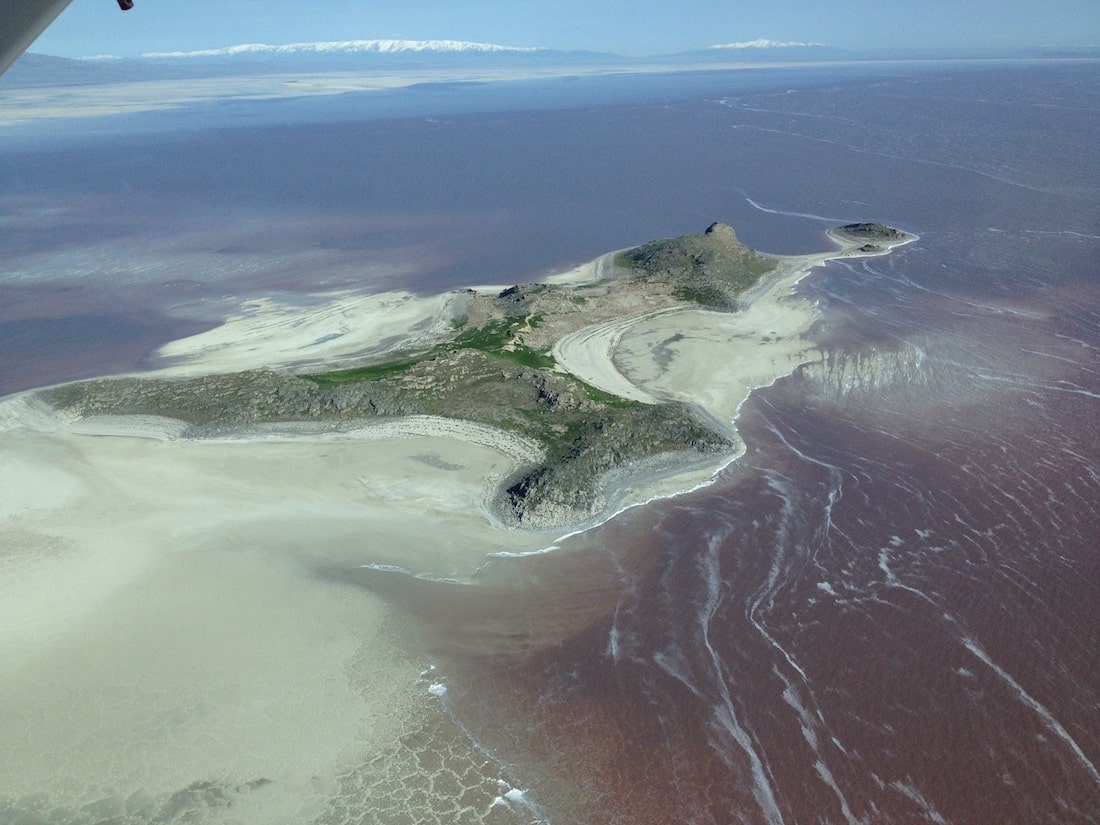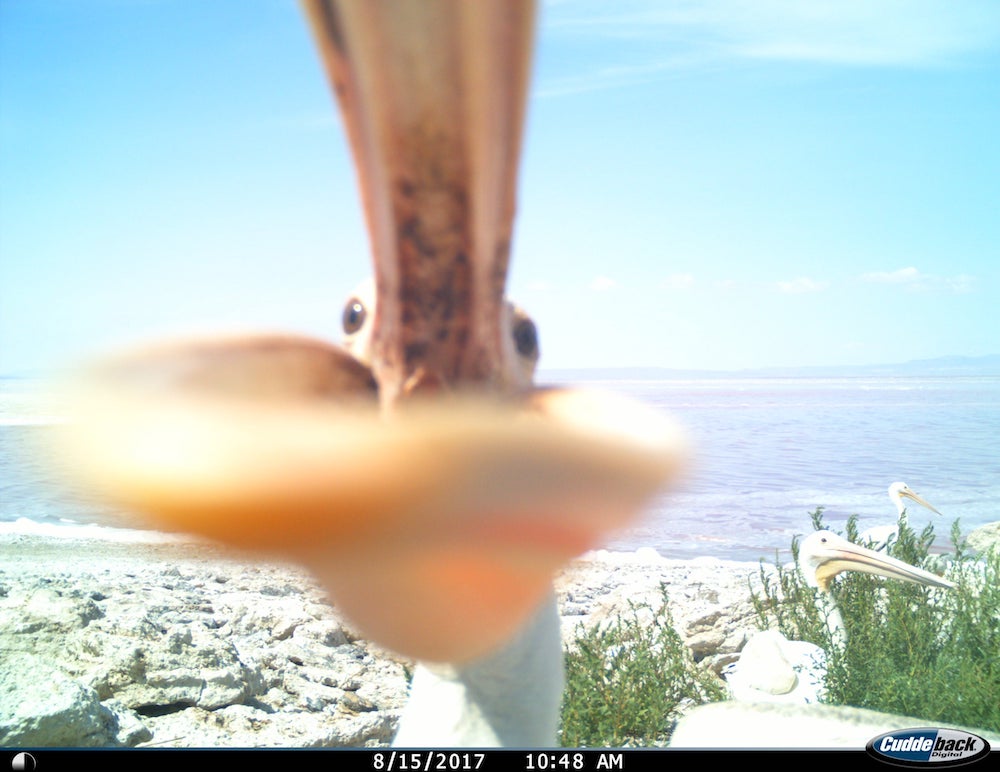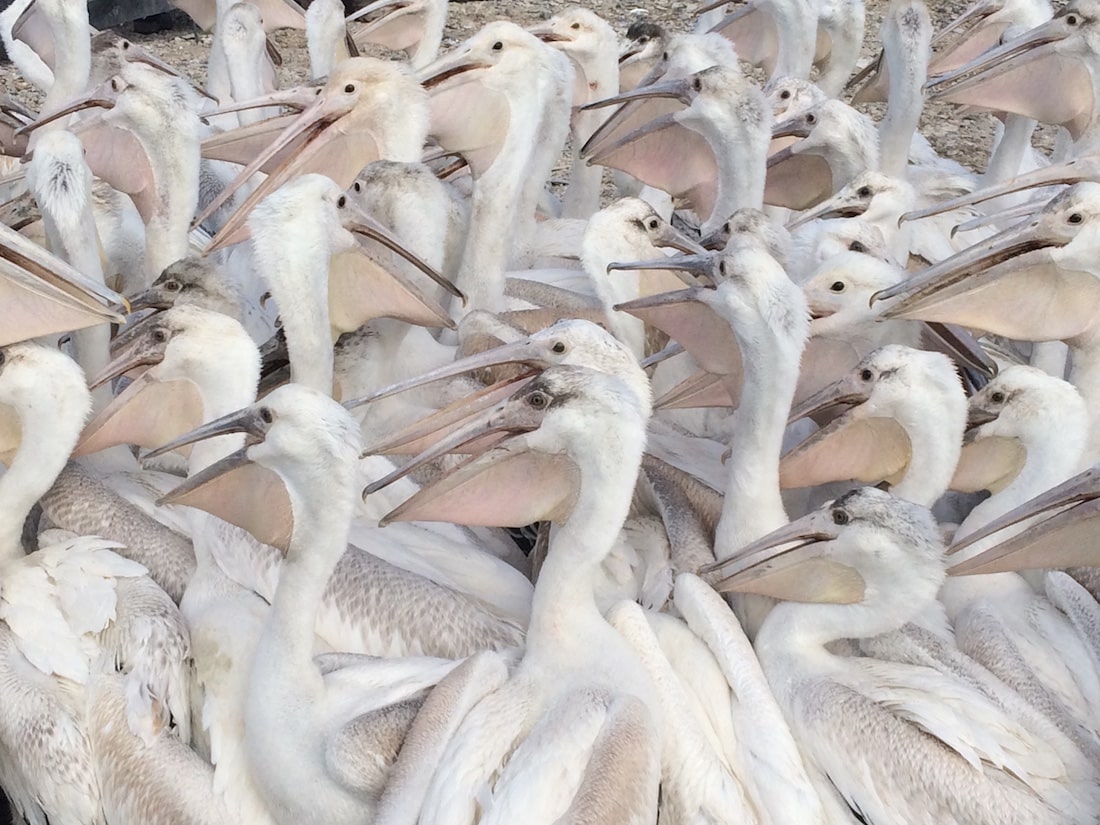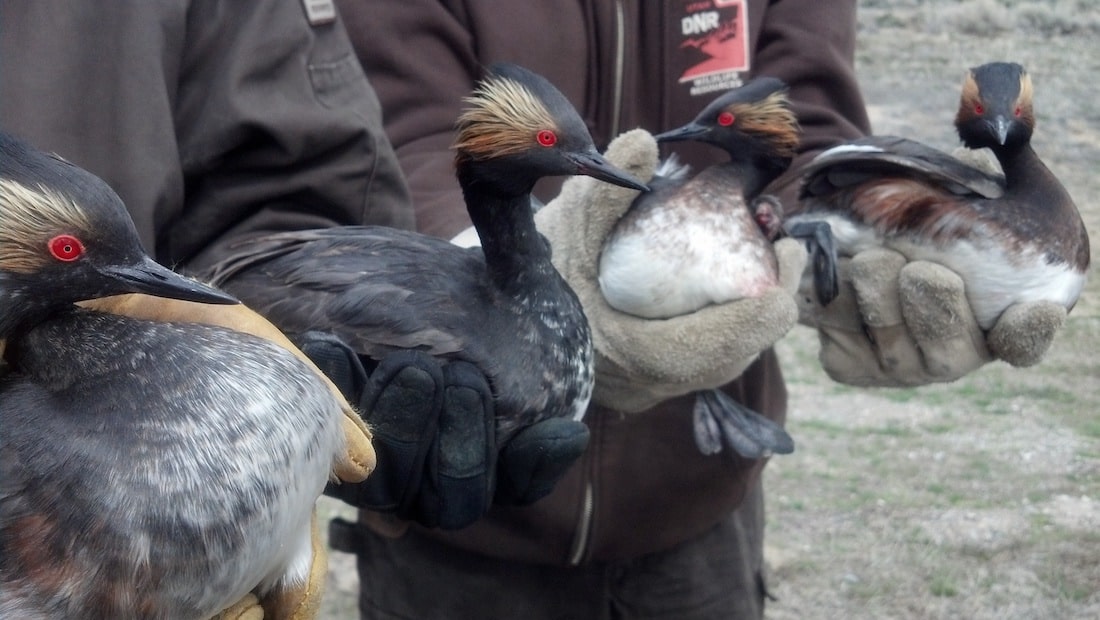The Great Salt Lake Is An ‘Oasis’ For Migratory Birds
12:28 minutes

In the northern reaches of Utah’s Great Salt Lake sits Gunnison Island, a narrow strip of land just a mile long and half a mile wide. Despite its small size, the island hosts the world’s second largest white pelican rookery, with an average of 20,000 birds and 6,000 nests. Biologist Jaimi Butler of Westminster College’s Great Salt Lake Institute calls the birds the “polar bears” of Great Salt Lake—because as lake waters drop, the birds’ island refuge is now threatened by humans, coyotes, and other predators.
Butler and her team have installed cameras on the island, and citizen scientists can now use these “PELIcam” images to help Butler and her colleagues catalog the white pelican population on the island—and the appearance of predators, too. Sign up here!



In this interview, recorded live at the Eccles Theater in Salt Lake City, Butler talks about the lifestyle of these enigmatic birds, and some of the unique life that calls the Great Salt Lake its home.
Jaimi Butler is a coordinator for the Great Salt Lake Institute at Westminster College.
IRA FLATOW: This is Science Friday. I’m Ira Flatow, coming to you from the Eccles theater in Salt Lake City.
[CHEERING]
For migrating birds flying for thousands of miles, did you know that Utah is a very popular pit stop? Why is that? The Great Salt Lake. It’s like a giant oasis, a service station where the birds can feast, fatten up, and rest. In fact, 10 million birds– 10 million– stop by the Great Salt Lake every year. And if you’re counting, that is three times as many birds as people living in Utah.
Yeah. And there are some pretty charismatic species who call the Great Salt Lake their part-time home. My next guest is here to tell us all about a few. Jaimi Butler is a coordinator of the Great Salt Lake Institute at Westminster College here in Salt Lake City. Welcome to the program.
[APPLAUSE]
Tell us why the lake is so special to the migrating birds.
JAIMI BUTLER: Well, I mean, we all know that Great Salt Lake has salt in it, right? And a lot of times, people say to me, oh, well it’s dead or nothing lives in there. And really, it’s so alive that sometimes it smells. And you all might have smelled that smell. In fact, my son John often tells me, mom, it reminds me of you.
IRA FLATOW: Love comes in many flavors.
JAIMI BUTLER: It does.
IRA FLATOW: And smells.
JAIMI BUTLER: Lots of different smells.
IRA FLATOW: Is there anything special about the salt that attracts the birds?
JAIMI BUTLER: Well, I think one of the really cool things about Great Salt Lake is that it’s not just salty. It’s super hyper-saline to freshwater and everything in between. And so that’s a huge diversity of habitats for lots of different microorganisms and bugs and then the birds that eat all of those bugs.
IRA FLATOW: So the lake is full of shrimp, too. Is it not?
JAIMI BUTLER: Oh yeah, that was my first love at Great Salt Lake, is the brine shrimp. Brine shrimp are really special because they’re the only organism that really live– the macroinvertebrate that lives in Great Salt Lake full-time. And the really cool thing about them is that they lay these hard wild cysts. They’re like the little eggs that people harvest and use as fish food. And those little brine shrimp, they can hatch out in the springtime and repopulate the lake for all of those birds. And one of my favorite facts about brine shrimp is that sometimes in Great Salt Lake, there’s so many brine shrimp, there’s a biomass equal to 1.8 million people in the lake at one time.
IRA FLATOW: Wow.
JAIMI BUTLER: So 1.– I mean, like the Wasatch Front in Great Salt Lake at one time.
IRA FLATOW: What other kinds of birds do you find? Name some of the popular birds that are in the Great Salt Lake.
JAIMI BUTLER: I mean, it’s hard to name. There’s 260 species of birds that live at Great Salt Lake at sometime during the year. Definitely eared grebes. They’re these little tiny water birds and they feed primarily on brine shrimp. So every single day, those little eared grebes, they have to eat 28,000 brine shrimp. So they pick them out one by one out of the water. They don’t filter feed. Every second, they have to catch two brine shrimp.
IRA FLATOW: Every second.
JAIMI BUTLER: Every second.
IRA FLATOW: Another unusual species that loves to hang out is the white pelican, there are all these white Pelicans.
JAIMI BUTLER: American White Pelicans come to Great Salt Lake to breed. So there is lots of these little barren islands that they come to scratch their little barren nests and lay their eggs and breed.
IRA FLATOW: We’re not taking calls this hour, but if you have any questions, we have a couple of microphones in the aisles. Feel free to come and ask your questions. And there’s a huge colony living on an island called Gunnison Island, right?
JAIMI BUTLER: Yeah. Gunnison Island, it’s a protected island. So the only way that you can go there is if you trespass, which you shouldn’t do. And the only other way is to go with the Utah Division of Wildlife Resources, who manages and conserves the populations of brine shrimp and birds at Great Salt Lake. And this island is a couple miles long by maybe half a mile wide. And it doesn’t have any trees, it’s very rocky, and there’s just like small vegetation on there. It’s exactly perfect for pelicans.
IRA FLATOW: Wow. You were talking about the odor of birds before. Does Gunnison have its own unique odor?
JAIMI BUTLER: Yeah. So I mean, maybe some of you have cats. And you could imagine putting your head in the litter box and then maybe timesing it by 100 and adding some rotten fish and dead birds into the mix. And that’s what it smells like.
[LAUGHTER]
It like, stays.
[APPLAUSE]
IRA FLATOW: Yeah.
JAIMI BUTLER: And I don’t mean that in a bad way.
IRA FLATOW: That’s why I have five grand dogs.
JAIMI BUTLER: I did– you know, we do use these– I think behind me I have this scarf on. And I brought you one of these from Great Salt Lake Institute, just in case I stink really bad. Then, you can just put that on.
IRA FLATOW: I’m glad I’m not sticking my head in the box on this. This is beautiful. So you, you’re actually holding– is it tough to catch those birds? What are you doing, what’s going on in that picture?
JAIMI BUTLER: So in that picture, that’s a juvenile pelican right before it flies. And one of the ways that the Utah Division of Wildlife Resources tries to understand more about these pelicans is they catch them and they put these green wing tags with a white marker on them with a numerical code, so that people all around the world can tell us when they see these birds.
So bird nerds, photographers, if you’re out there and you’re along the Pacific or the Central Flyway and you have pelicans, please tell us if you see these pelicans with green wing tags. But it turns out, you know, pelicans are very shy. They don’t really like humans. They’re way smarter than we are. And the baby pelicans are much easier to catch when they can’t fly. So we herd them into these little corrals where we’re able to catch them and put the tags on them.
IRA FLATOW: We’re watching a video of the pelicans being herded. Are there dogs that do that or?
JAIMI BUTLER: No, the Utah Division of Wildlife just pays people not very much money to do this.
[LAUGHTER]
IRA FLATOW: It’s pretty funny. And we have the video up at sciencefriday.com/pelicans if you want to see it. Over and over again, which I’m sure you want to do that. And you have set cameras up all over the island, right?
JAIMI BUTLER: Yeah. So in 2016, we were watching water levels at Great Salt Lake decrease and we were watching these land bridges form to their island where they’re breeding. And these are little ground nesting birds that if four-legged animals can walk out on this highway, it could impact these populations greatly. And so we decided to put some Peli Cams on Gunnison Island.
[LAUGHTER]
IRA FLATOW: Yes?
JAIMI BUTLER: That’s the best part about the whole project, is the name. So we put these Peli cams on Gunnison Island, and there’s 15 of them. We originally just planned for one of them and it was going to be a live camera where we could log in. And the students I work with at Great Salt Lake Institute at Westminster College, they could watch all of these images and see if predators were going out on these land bridges.
We can see when the birds were arriving, if they were starting to arrive earlier. You know, we could tell all sorts of things. And then we were like, well, if we can put one camera, we could put 15. Why not? And so now, we have two seasons of the Peli cams, two breeding seasons of Peli cams with over 200,000 images that we need help analyzing.
IRA FLATOW: They don’t like, take selfies of each other–
JAIMI BUTLER: Well, they have dance parties and they–
IRA FLATOW: They do take selfies.
JAIMI BUTLER: Yeah, they take selfies.
IRA FLATOW: I’ve never seen a– we’re looking at bird selfies.
[LAUGHTER]
I can’t top that, so I’m going to the audience. Question here.
AUDIENCE: Yes. There’s been a lot of talk about migration and changes with migration patterns because of climate change. And I was just wondering if you’ve noticed a big change in the populations. And has there been an increase or decrease that is natural or not natural to our specific area? Are they on course or off course because of that?
JAIMI BUTLER: Thank you so much for this question. I really love this question and I’m so glad you asked it. So in the case of eared grebes, there is actually more eared grebes that are coming to Great Salt Lake every year because of our abundant brine shrimp that they love to feast on and fatten on. And the Utah Division of Wildlife Resources has done a really great job of managing their populations, the brine shrimp populations, even though they’re harvested.
And so we’ve actually seen an increase in eared grebes. With pelicans, we don’t really know. So you’re right that some research has indicated birds are starting to migrate earlier and that can impact them with severe spring storms and less food. We don’t know with the pelicans. We do know that their populations have stayed pretty stable over the last five years or so, but we don’t know ’cause we don’t have Peli cams. And so we need your help to–
IRA FLATOW: Now that’s– I’m glad you brought that up, because our audience can actually help you with this project. Tell us how that works.
JAIMI BUTLER: Yeah, please go to Zooniverse.org. And Zooniverse is so awesome and they have been such a big help in this project, because we had 200,000 images to look at. And Zooniverse is a community-based science platform where anybody can go and they can help us analyze all of these pictures of pelicans. Like, I don’t know if you can see it, but there’s some little teeny, tiny, ugly, salmon-colored babies under that pelican. And you can click on them and tell us all about it.
IRA FLATOW: So you want them to look at the photos that you’ve taken and sort through the photos and tell you what they see in each photo.
JAIMI BUTLER: Yeah. Do you see babies, do you see pelicans with wing tags, do you see predators, do you see humans?
IRA FLATOW: Well, if you want to find out and you want to get involved in this, this sounds like a lot of fun. We have a link to the project at our website, at sciencefriday.com/pelicans if you want to get involved in this. Jaimi Butler, coordinator at the Great Salt Lake Institute at Westminster College here in Salt Lake City. Thank you.
JAIMI BUTLER: Thank you, Ira.
[APPLAUSE]
IRA FLATOW: And if you want to spy on some of those pelicans yourself and help out Jaimi’s research, as I said before, you can go to sciencefriday.com/pelicans to sign up. And we hope all of you will go do that. After the break, we’ll talk about the exotic life hiding up in tree canopies. And one scientist’s mission to bring biology lessons behind bars. Stay with us. Taking us to the break, our musical guest for the evening, Salt Lake City’s own, The Boys Ranch.
[APPLAUSE]
[MUSIC PLAYING]
This is Science Friday from WNYC Studios.
Copyright © 2018 Science Friday Initiative. All rights reserved. Science Friday transcripts are produced on a tight deadline by 3Play Media. Fidelity to the original aired/published audio or video file might vary, and text might be updated or amended in the future. For the authoritative record of Science Friday’s programming, please visit the original aired/published recording. For terms of use and more information, visit our policies pages at http://www.sciencefriday.com/about/policies/
Christopher Intagliata was Science Friday’s senior producer. He once served as a prop in an optical illusion and speaks passable Ira Flatowese.